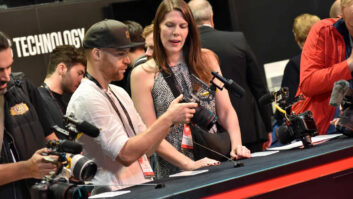TVBEurope’s third IT Broadcast Workflow conference, which took place in London this week, was a good reflection of the current broadcast climate: cautious, realistic, but increasingly optimistic, even if more of the emphasis was on total cost of ownership than the creative and business possibilities of file-based systems, writes David Fox.
There’s been “an awful lot of changes” since the first conference, said its chairman, Jeremy Bancroft, director, Media Asset Capital, but “the integration of IT and broadcast technology is still a challenge.
“Vendors will tell you it’s all straightforward and standards-based and it all works. It isn’t all straightforward. It isn’t easy. And there are problems at every turn. But that’s not to say we shouldn’t do it,” he told a packed audience.
His experience is that most projects run into difficulties at some time, most of which are down to one thing: communications, not just between the equipment, but also between the customer and the vendor or between multiple vendors. “Managing the communication between the parties is vital.”
Broadcasters often face a choice between a difficult integration between systems from various vendors, or getting a system that is just about good enough from a single vendor.
Going tapeless may mean less tape, but it does mean more formats. There are a huge number of variables to taking into account with files – so many that when Amberfin’s CTO, Bruce Devlin, calculated how long it would take to test a pop promo in every combination of every file format, audio format, frame rate, resolution and wrapper that its systems could handle, he found it would take nearly 62 years to play them all back in real-time.
However, when the IT broadcast workflow runs smoothly, it can make a huge difference. Just what is possible with an efficient IT broadcast workflow was shown by MTV Networks North, whose v-p Channel Operations, Thomas Popma, explained that just three years ago it had “a very costly, complex and frustrating” broadcast chain, where its ten channels were transmitted from six different playout contractors, and “it was impossible to grow for us”.
Now it has 45 channels (broadcasting in 18 languages), with 25 of those added in the last six months, and plans for many more, thanks to tight integration between its channel management, MAM and playout systems, and an ability to add new channels as simply as setting up a new website.
Its costs have dropped by 60% and it only needs to employ about two people per channel.
This sort of story is exceptional, and was achieved with a greenfield site. Some of the others had more cautionary tales, but even then the hard-won benefits were worth it. Some of the lessons learned include: the need for test platforms, so that you can try out software implementations without risking any on-air systems; the necessity for a backup plan, especially for disaster recovery; and advice to “invest as much in your people as in your technology”.
There will be a full report on all the case studies in the August issue of TVBEurope.
Image: Chris Taylor







